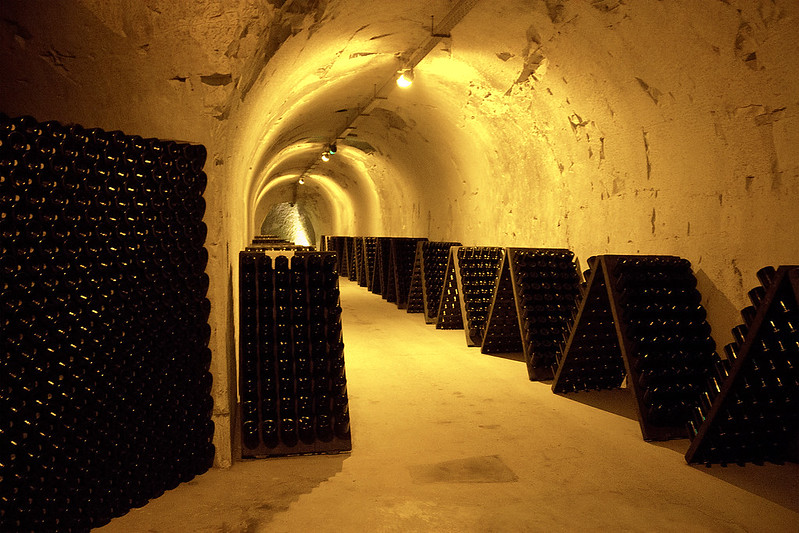
You don't normally think of Veterans Day and Champagne together, but there is a connection. Although Champagne typically calls to mind joyful celebrations, ironically the Champagne region has been the scene of some of the bloodiest battles in history. Attila the Hun and his army of 700,000 men were defeated there in a battle that took 200,000 lives in one day. Champagne hosted many of the battles of the Hundred Years' War, the Thirty Years War, the Napoleonic Wars . . . you get the idea. It's a great place to grow grapes and make wine, but a really bad place to be when European monarchs and tyrants are in a snit.
World War I was Champagne's darkest hour. During the war, the front line trenches zig-zagged through the vineyards, and German artillery and aerial bombardment was unrelenting. Champagne lost about one-half of its population and 40 percent of its vineyards. The capitol city, Reims, was flattened, and for much of the war its inhabitants lived underground in cavernous champagne storage cellars called crayères.
Ironically, the 1914 vintage -- known as the "blood vintage" -- was considered the best of the 20th century. Although the men were away at war, it was critical that the harvest be brought in. So old men, women and children picked the grapes, despite persistent Germany artillery fire. The harvest was successful, but the vineyards ran red with the blood of countless women and children.
The "war to end all wars" ended on the 11th hour of the 11th day of the 11 month of 1918 - "Armistice Day." Of course, it really wasn't the war to end all wars, and November 11 became what we now celebrate as Veterans Day, so let's raise a toast to all our veterans!
The basics on Champagne.
- What makes Champagne so special? Three things, really.
- Champagne can only be produced in a defined region in northeast France that has a unique terroir that produces wines unlike anywhere else.
- It is made primarily from Pinot Noir, Pinot Meunier and Chardonnay (four other grapes are authorized).
- The way it's made -- the "Méthod Champenoise" (known outside of Champagne as the "Méthod traditionnelle") -- shapes its identity. Simplistically, it is the product of two separate alcoholic fermentations, the first in a vat when grapes are fermented into a base wine, and the second in the same bottle that is ultimately sold to the consumer. The wine is then aged in bottle, producing a wine with vibrant acidity and aromas of freshly baked bread or nuts.
- Non Vintage ("NV"). Unlike most wines, you won't find a vintage year on most champagne bottles. That is because it is usually made from a blend of different grapes and vintages to produce a consistent "house style." In contrast, "Vintage" champagne is produced in exceptional years and shows the characteristics of that year.
- Prestige Cuvée. Each champagne house produces a top-of-the-line "prestige cuvée." For example, Veuve Cliquot produces *La Grande Dame."
- Blanc de Blancs. A Champagne that is made from only white grapes (predominantly Chardonnay.) In contrast, Blanc de Noirs is white champagne made from red grapes, and it tends to be more fruity and powerful.
- Sweetness levels. From least to most sweet, the levels are Brut Nature, Extra Brut, Brut, Extra-Sec, Sec, Demi-Sec and Doux. Most American consumers prefer Brut.
Our wine of the week is a Billecart-Salmon Brut Reserve (about $40 retail). Billecart-Salmon has a good reputation, and our expectations were high. We were somewhat disappointed, however, and concluded that there were better options for the price. This is a light Champagne, made from 30 percent Pinot Noir, 30 percent Chardonnay and 40 percent Pinot Meunier. The straw yellow wine is aged on its lees (dead yeast cells that give wine a toasty note) for 30 months. Although its effusive stream of small bubbles suggested a good quality champagne, when we tasted it there wasn't much more than a tart acidity, a brioche aroma and a hint of pear.
- An alternative: Veuve Cliquot Brut NV ($45 retail). The Veuve Cliquot has a consistent style and provides good value for the money. It's a blend of Pinot Noir, Pinot Meunier and Chardonnay, and has both a great intensity and a silkiness. Look for notes of citrus, brioche and white fruits.
- Champagne is great as an aperitif, but also pairs well with many foods, such as fish, fried foods and light meats.
Cheers!
